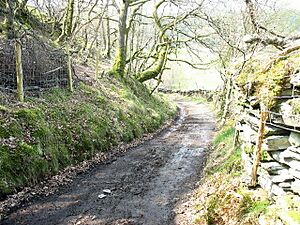Sarn Helen facts for kids
Sarn Helen is the name for several parts of old Roman roads in Wales. This long route stretches about 160 miles (257 km). It winds its way through the middle of Wales. The road connects Aberconwy in the north with Carmarthen in the west.
Even though it's very long, experts still discuss its exact path. Many parts of Sarn Helen are now used as modern roads. Other sections can still be seen today. But some large parts of the road have been lost and cannot be found.
The road is named after Saint Elen of Caernarfon. She was a Celtic saint. Her story is told in The Dream of Macsen Wledig. This is part of a famous Welsh collection called Mabinogion. People say she ordered these roads to be built in Wales. This happened in the late 300s AD.
Contents
The Route of Sarn Helen
From Aberconwy to Carmarthen
In the north, the road is thought to follow the western side of the river Conwy. It starts from Canovium, a Roman fort at Caerhun. The route then goes through Trefriw and on to Betws-y-Coed. There was also a branch road leading to Caer Llugwy near Capel Curig.
The main route then passed through Dolwyddelan. It went through the Cwm Penamnen valley. It also went past the higher areas of Cwm Penmachno. The road then continues past Llan Ffestiniog. It leads to the Roman fort of Tomen y Mur. This fort is near Trawsfynydd. From there, it keeps going south towards Dolgellau.
South of Dolgellau, the road crosses Waen Llefenni. It goes into Cwm yr Hengae to Aberllefenni. A part of the narrow-gauge Corris Railway might follow the old Roman road. This is between Aberllefenni and Maespoeth Junction. A small road on the east side of the Afon Dulas near Esgairgeiliog might also be Roman. However, the Roman road might have stayed on the west side of the Dulas. This would be between Corris and Ffridd Gate.
Sarn Helen might have crossed the Afon Dyfi at a ford or ferry. This crossing would have been near Cefn Caer. Cefn Caer was a small Roman fort at Pennal in southern Gwynedd.
In Ceredigion, a part of a B-road at Bronant is Roman. Six miles south of there is a long section through Stag's Head. The road can be seen at Llanio. Here, there was a small Roman fort called Bremia. The route then goes southeast towards the Dolaucothi Gold Mines. These mines are near Pumsaint in Carmarthenshire.
After the gold mines, it passes the large Roman fort of Luentinum. Finally, it reaches its historical end at Alabum. Today, this place is known as Llandovery. The Roman camp was on Llanfair Hill. In the 1100s, the Normans used part of the old Roman site. They built the medieval church of St Mary's Church, Llanfair-ar-y-bryn there. The fort was at a point where Roman roads met. These roads connected the Dolaucothi gold mines to Moridunum (Carmarthen) and Y Gaer near Brecon.
From Neath to Brecon
Another part of a Roman road is also called Sarn Helen. This section goes northeast from Neath (which the Romans called Nidum). It leads to Banwen at the southern edge of the Brecon Beacons National Park. It continues northeast through the park. It passes northwest of Ystradfellte, below Fan Frynych. Then it crosses Mynydd Illtud on its way to the Roman fort of y Gaer (called Cicucium by the Romans).
Outdoor Fun on Sarn Helen
Cycling Trail
There is a long mountain bike route called the Sarn Helen Trail. It follows parts of the old Roman road. This trail is about 270 miles (435 km) long. It was created in 1996. The route goes between Conwy on the North Wales coast and Worms Head on the Gower Peninsula.
Running Race
The road also gives its name to an annual running event. It is called the Sarn Helen Hill Race. This race starts and finishes in Lampeter in mid-Wales. The race is about 16.5 miles (26.5 km) long. It started in 1980 and happens every May. It is known for mixing the speed of road running with the challenges of cross-country and fell running. It takes place on a beautiful and tough course.
See also
 In Spanish: Sarn Helen para niños
In Spanish: Sarn Helen para niños


